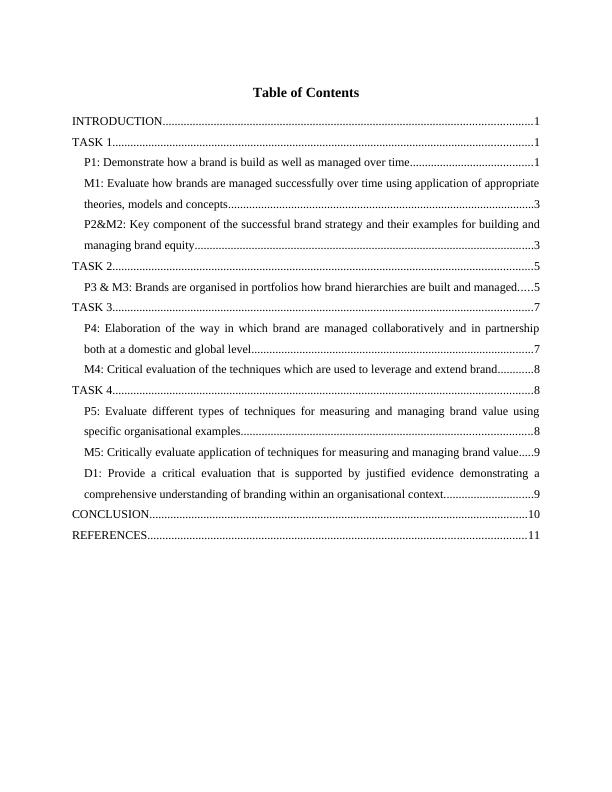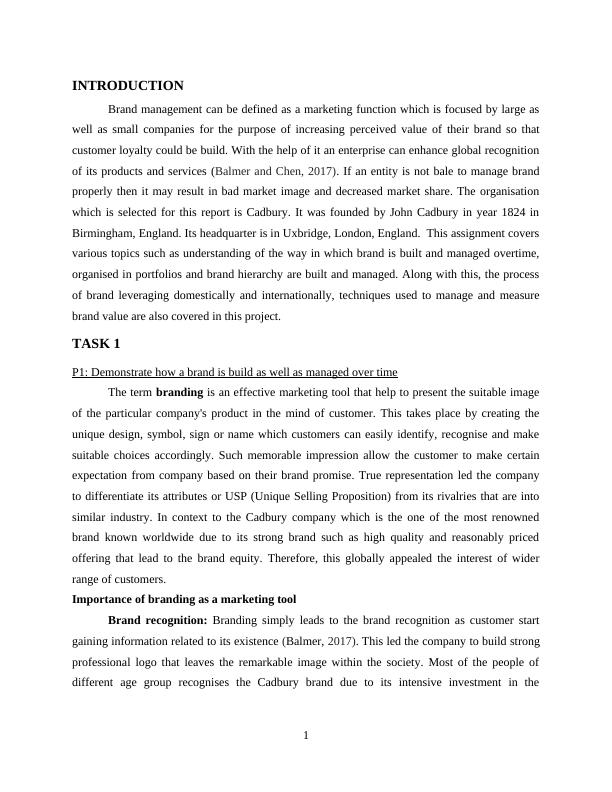Brand Management: Building and Managing Brands Over Time
Added on 2023-01-18
14 Pages5186 Words33 Views
Brand Management

Table of Contents
INTRODUCTION...........................................................................................................................1
TASK 1............................................................................................................................................1
P1: Demonstrate how a brand is build as well as managed over time.........................................1
M1: Evaluate how brands are managed successfully over time using application of appropriate
theories, models and concepts......................................................................................................3
P2&M2: Key component of the successful brand strategy and their examples for building and
managing brand equity.................................................................................................................3
TASK 2............................................................................................................................................5
P3 & M3: Brands are organised in portfolios how brand hierarchies are built and managed.....5
TASK 3............................................................................................................................................7
P4: Elaboration of the way in which brand are managed collaboratively and in partnership
both at a domestic and global level..............................................................................................7
M4: Critical evaluation of the techniques which are used to leverage and extend brand............8
TASK 4............................................................................................................................................8
P5: Evaluate different types of techniques for measuring and managing brand value using
specific organisational examples.................................................................................................8
M5: Critically evaluate application of techniques for measuring and managing brand value.....9
D1: Provide a critical evaluation that is supported by justified evidence demonstrating a
comprehensive understanding of branding within an organisational context..............................9
CONCLUSION..............................................................................................................................10
REFERENCES..............................................................................................................................11
INTRODUCTION...........................................................................................................................1
TASK 1............................................................................................................................................1
P1: Demonstrate how a brand is build as well as managed over time.........................................1
M1: Evaluate how brands are managed successfully over time using application of appropriate
theories, models and concepts......................................................................................................3
P2&M2: Key component of the successful brand strategy and their examples for building and
managing brand equity.................................................................................................................3
TASK 2............................................................................................................................................5
P3 & M3: Brands are organised in portfolios how brand hierarchies are built and managed.....5
TASK 3............................................................................................................................................7
P4: Elaboration of the way in which brand are managed collaboratively and in partnership
both at a domestic and global level..............................................................................................7
M4: Critical evaluation of the techniques which are used to leverage and extend brand............8
TASK 4............................................................................................................................................8
P5: Evaluate different types of techniques for measuring and managing brand value using
specific organisational examples.................................................................................................8
M5: Critically evaluate application of techniques for measuring and managing brand value.....9
D1: Provide a critical evaluation that is supported by justified evidence demonstrating a
comprehensive understanding of branding within an organisational context..............................9
CONCLUSION..............................................................................................................................10
REFERENCES..............................................................................................................................11

INTRODUCTION
Brand management can be defined as a marketing function which is focused by large as
well as small companies for the purpose of increasing perceived value of their brand so that
customer loyalty could be build. With the help of it an enterprise can enhance global recognition
of its products and services (Balmer and Chen, 2017). If an entity is not bale to manage brand
properly then it may result in bad market image and decreased market share. The organisation
which is selected for this report is Cadbury. It was founded by John Cadbury in year 1824 in
Birmingham, England. Its headquarter is in Uxbridge, London, England. This assignment covers
various topics such as understanding of the way in which brand is built and managed overtime,
organised in portfolios and brand hierarchy are built and managed. Along with this, the process
of brand leveraging domestically and internationally, techniques used to manage and measure
brand value are also covered in this project.
TASK 1
P1: Demonstrate how a brand is build as well as managed over time
The term branding is an effective marketing tool that help to present the suitable image
of the particular company's product in the mind of customer. This takes place by creating the
unique design, symbol, sign or name which customers can easily identify, recognise and make
suitable choices accordingly. Such memorable impression allow the customer to make certain
expectation from company based on their brand promise. True representation led the company
to differentiate its attributes or USP (Unique Selling Proposition) from its rivalries that are into
similar industry. In context to the Cadbury company which is the one of the most renowned
brand known worldwide due to its strong brand such as high quality and reasonably priced
offering that lead to the brand equity. Therefore, this globally appealed the interest of wider
range of customers.
Importance of branding as a marketing tool
Brand recognition: Branding simply leads to the brand recognition as customer start
gaining information related to its existence (Balmer, 2017). This led the company to build strong
professional logo that leaves the remarkable image within the society. Most of the people of
different age group recognises the Cadbury brand due to its intensive investment in the
1
Brand management can be defined as a marketing function which is focused by large as
well as small companies for the purpose of increasing perceived value of their brand so that
customer loyalty could be build. With the help of it an enterprise can enhance global recognition
of its products and services (Balmer and Chen, 2017). If an entity is not bale to manage brand
properly then it may result in bad market image and decreased market share. The organisation
which is selected for this report is Cadbury. It was founded by John Cadbury in year 1824 in
Birmingham, England. Its headquarter is in Uxbridge, London, England. This assignment covers
various topics such as understanding of the way in which brand is built and managed overtime,
organised in portfolios and brand hierarchy are built and managed. Along with this, the process
of brand leveraging domestically and internationally, techniques used to manage and measure
brand value are also covered in this project.
TASK 1
P1: Demonstrate how a brand is build as well as managed over time
The term branding is an effective marketing tool that help to present the suitable image
of the particular company's product in the mind of customer. This takes place by creating the
unique design, symbol, sign or name which customers can easily identify, recognise and make
suitable choices accordingly. Such memorable impression allow the customer to make certain
expectation from company based on their brand promise. True representation led the company
to differentiate its attributes or USP (Unique Selling Proposition) from its rivalries that are into
similar industry. In context to the Cadbury company which is the one of the most renowned
brand known worldwide due to its strong brand such as high quality and reasonably priced
offering that lead to the brand equity. Therefore, this globally appealed the interest of wider
range of customers.
Importance of branding as a marketing tool
Brand recognition: Branding simply leads to the brand recognition as customer start
gaining information related to its existence (Balmer, 2017). This led the company to build strong
professional logo that leaves the remarkable image within the society. Most of the people of
different age group recognises the Cadbury brand due to its intensive investment in the
1

advertisement technique. This leads the company to gain the trust of customers and successfully
converted first time buyer into loyal customers.
Survive in temporary crises: Certain brand which has the genuine quality can handle
the crises as well as re-establish the trust over customers. As business function within dynamic
environment so unfavourable condition can led to the destructive condition. Herein, Cadbury has
even faced huge crises such as its 'Worm controversy' that sharply led down the sales of
Cadbury. But the representative of company came forward and explained that the existence of
worm is not due to the manufacturing process but because of poor storage condition within retail
store. Hence, it changed it packaging and run various advertisement campaign which
successfully help company to regain its market share.
Maintain the pride of employees over brand: The company can only attain its
objective with the significant efforts of the employee. If the personnel works for the recognised
brand like Cadbury then it automatically develop the job satisfaction as well as pride to be the
part of specific brand. This led the workforce to participate in the functioning of business with
the motive to gain the better position. Group of such competitive members led down the issues
like high turnover rate, even they openly participate in the change management process.
Enhances the brand value: Branding is vital to generate present as well as future
business. If the brand is strongly established then it enhances the value and leverage supreme
level of options that is gained by customer from the company (Chinomona, 2016). This is the
appealing strategy that motivate the firm to attract the customers and deliver value which finally
connect the customers with the company. Herein, respected company remain more concern in
order to maintain the expectation of customer. So being customer oriented it has the wider edge
of the customer that does nor prefer switching to the other product.
Emergence of branding in business practice
With the increase in competition and globalisation has lead the awareness in all the
organisation whether large or small to focuses on the branding. As this is what can distinguish
the offering of one company with the other. Cadbury was founded in the year 1824 and has
strong global presence all around the world that has successfully helped the company to gain the
huge customer base. Along with that the emergence of branding is due to the efforts of top
executives that made enormous effort to build the strong image of company and collectively
attain the goal and objective of an organisation. This is the current stage has enhance the value of
2
converted first time buyer into loyal customers.
Survive in temporary crises: Certain brand which has the genuine quality can handle
the crises as well as re-establish the trust over customers. As business function within dynamic
environment so unfavourable condition can led to the destructive condition. Herein, Cadbury has
even faced huge crises such as its 'Worm controversy' that sharply led down the sales of
Cadbury. But the representative of company came forward and explained that the existence of
worm is not due to the manufacturing process but because of poor storage condition within retail
store. Hence, it changed it packaging and run various advertisement campaign which
successfully help company to regain its market share.
Maintain the pride of employees over brand: The company can only attain its
objective with the significant efforts of the employee. If the personnel works for the recognised
brand like Cadbury then it automatically develop the job satisfaction as well as pride to be the
part of specific brand. This led the workforce to participate in the functioning of business with
the motive to gain the better position. Group of such competitive members led down the issues
like high turnover rate, even they openly participate in the change management process.
Enhances the brand value: Branding is vital to generate present as well as future
business. If the brand is strongly established then it enhances the value and leverage supreme
level of options that is gained by customer from the company (Chinomona, 2016). This is the
appealing strategy that motivate the firm to attract the customers and deliver value which finally
connect the customers with the company. Herein, respected company remain more concern in
order to maintain the expectation of customer. So being customer oriented it has the wider edge
of the customer that does nor prefer switching to the other product.
Emergence of branding in business practice
With the increase in competition and globalisation has lead the awareness in all the
organisation whether large or small to focuses on the branding. As this is what can distinguish
the offering of one company with the other. Cadbury was founded in the year 1824 and has
strong global presence all around the world that has successfully helped the company to gain the
huge customer base. Along with that the emergence of branding is due to the efforts of top
executives that made enormous effort to build the strong image of company and collectively
attain the goal and objective of an organisation. This is the current stage has enhance the value of
2

End of preview
Want to access all the pages? Upload your documents or become a member.
Related Documents
Brand Management: Strategies for Building and Managing Brand Equitylg...
|17
|5668
|84
Managing Brand Equitylg...
|17
|5797
|200
Brand Management: Importance, Strategies, and Successlg...
|7
|2156
|29
Brand Management: Strategies, Theories, and Evaluationlg...
|19
|4229
|33
Brand Management: Importance, Strategies, and Brand Equity Managementlg...
|19
|6388
|41
Brand Management: Building and Managing Brand Equitylg...
|19
|6895
|98
